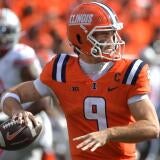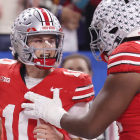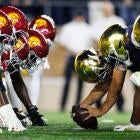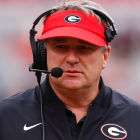Potential college football rule changes aim to limit plays and exposures while shortening the game
Limiting exposures to improve player safety has become a top priority
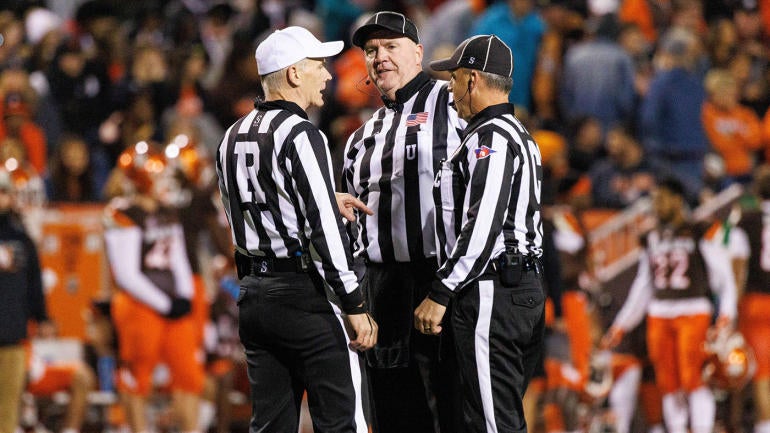
Buried in the 11th paragraph of a 16-year-old NCAA press release is evidence of the most significant upheaval that's come to college football in its modern era. Addressing game length, the NCAA Football Rules Committee in February 2006 recommended what then seemed like two minor changes.
Beginning that season, the clock would start when toe met leather on kickoffs, instead of when the opposing team touched it. Also, the clock would start with the "ready for play" signal from the referee, not when the ball is snapped after a change of possession.
"I don't remember how that came to the committee," former rules chairman and Pittsburg State coach Chuck Broyles recalled. "It wasn't very well received."
What followed was less football -- much less. Coaches, especially offensive coordinators, howled. The drop in the number of plays per game was so profound that those thought-to-be minor changes ended up being so radical they lasted only one season. That season, total plays declined by more than 13 per game on average. The drop in average yards per team (33) was the most since 1954. The scoring average per team (24.1 points) remains the lowest in the last 31 years.
This week, the rules committee is undertaking an unprecedented project that could similarly reduce the number of plays we see on Saturdays. This time, unlike in 2006, it's being considered in the name of player safety.
The rules committee, at its annual meeting in Indianapolis this week, is considering its own version of playing less football. Membership is gathering statistics from the last 15 seasons to examine total snaps in a game, not just plays from scrimmage. Included in that total is extra points, two-point attempts and kickoffs along with plays from scrimmage. The committee may even find a way to incorporate the number of declined penalties (holding, pass interference, offsides) that involved a snap and at least some contact.
Steve Shaw, secretary-rules editor of the rules committee, calls the research singular in the group's history. In essence, it is attempting to account for every incidence of collision in a game defined by violence since 2007.
The result could impact everything from College Football Playoff expansion to existing court battles over head trauma.
"What we've really tried to do up to today is find every component of the game that we can find to keep the game moving," Shaw said. "We feel like we've squeezed that turnip to the end. We got all the juice out. The discussion is going to morph away from how much time elapses on your wristwatch to exposures of the student-athlete."
That word -- "exposure" -- has taken the place of "snaps" or "plays" among key stakeholders in the discussion. The change in semantics indicates the concern itself: Players are potentially "exposed" to harm when they play football. Playing less of it, then, is the goal.
Among what's being considered:
Treating incomplete passes the same as runs out of bounds. Beginning in 2008, the clock started after runs and fumbles out of bounds when the referee signaled "ready for play". Previously, the clock started on the snap after such plays. The committee is considering treating incomplete passes the same way. The rule would be in effect until late in the half or game, perhaps the last 2-5 minutes, according to Shaw.
No longer stopping the clock after first downs. This is a foundational piece of college football that differentiates it from the NFL. This change has long been considered, but the game's overseers have been hesitant, in part, because it would make the college game more like the NFL.
At stake, of course, is the delicate balance of the game that got out of whack for a year in 2006.
"We want to map those rules changes that, over time, would impact the clock," said Shaw, who is also the NCAA's national coordinator of officials. "I don't have a conclusion yet."
Rules changes are allowed every other year. This is one of those years. Executive producers from all major rightsholders -- CBS, ESPN, Fox, NBC -- have been invited to lend their input this week.
(Other unrelated broadcast considerations are being discussed in the rightsholder meetings. One example: Extra points -- an afterthought in college -- being shown side-by-side during TV commercials. That practice is already being used during some football timeouts and in golf telecasts.)
Anything ideas the committee generates this week are subject to approval later this year by the NCAA Playing Rules Oversight Panel. One encouraging sign: That panel didn't exist to review proposed rules changes in 2006.
"Some [rules changes] sound good, and then it takes two or three weeks into the season, or maybe even a year. You might say, 'Eh, it wasn't such a good idea,'" said Broyles, now 75 and retired in Pittsburg, Kansas.
Complicating matters: One size doesn't fit all in college football. If the idea is to run fewer plays, how does that impact the likes of Wake Forest -- 86 plays per game over the last three seasons -- compared to option-oriented Navy (59)?
"I feel that we want the creativity we have in offenses," SEC commissioner Greg Sankey said. "We want different approaches. That's what is unique about the college game, still."
There are some who believe those 2006 changes gave rise to tempo offenses. Offensive coaches adapted by running plays faster with less time to get them onto the field. The numbers certainly support that assertion. The average of 64 plays per team in 2006 remain the fewest per game since 1964. A year later, in 2007, teams were snapping it an average of 72 times per game. The jump in yards per game (45 per team) was the largest since 1955.
Since 2007, plays per game haven't dipped below 68.4. The numbers emerging don't have much meaning yet. Early research over that 15-year period shows a spike in 2014, 176 total plays per game. In 2021, the average was down to 168.
Player safety is one of the reasons the ACC voted against an expanded playoff beginning in 2024. The conference is in the middle of a year-long "holistic review" of college football.
The concept of fewer plays per game has the support of commissioner Jim Phillips and his conference. Sankey said his conference's research shows that can reducing plays could mean the equivalent of athletes playing an average of 1.2 games fewer per season.
Legal liability has to be an overarching concern in any of these rule changes. Faking injuries has become a major issue. Shaw is already on record saying there will be no retreat on the enforcement of targeting despite criticism.
"This is a fight for our game," Shaw told CBS Sports last year.
It is imperative that a safer, more streamlined game can be delivered by the college football's stakeholders in 30 months when the CFP enters an exclusive 30-day negotiating window with ESPN for playoff rights that would start in 2026.
If not, the existence of the game itself will be at risk. There are still dozens of head trauma lawsuits against schools and the NCAA rolling through various courts.
"I think that's one of the things we will look at, the number of exposures, the number of plays in a game," Big 12 commissioner Bob Bowlsby said. "What we do during preseason camp, what we do in practice, what we do in offseason conditioning. See if there are ways we can reduce wear and tear, ways we can reduce live contact."
The proposed changes bubbled up in the last year. Sankey told CBS Sports the SEC Football Leadership Council -- consisting of active players -- recommend fewer plays last summer. When the 12-team playoff was introduced last June, "Literally, it was the exposures that were identified by our group," Sankey said.
The discussion was furthered in December 2021 when College Football Officiating (CFO) met with the FBS commissioners at the annual National Football Foundation dinner in Las Vegas. (CFO was established in 2008 as a merger of the NCAA and the Collegiate Commissioners Association to ensure proper application of rules and establishing a central officiating leader. Shaw is that current leader.)
"Rather than say, 'It took 3 hours, 38 minutes to play the game,' [the discussion has become] 'How many plays did it take? How many exposures?'" Shaw said.
Yes, the game's stakeholders are less concerned these days with the actual length of games than what occurs within that time period to the players who entertain us.
"Increased exposure does alter game [length]," Sankey said. "I don't get a lot of complaints about game lengths. It's a different game than the NFL. It should be. But those exposures over a year's time have to be [a concern]."






